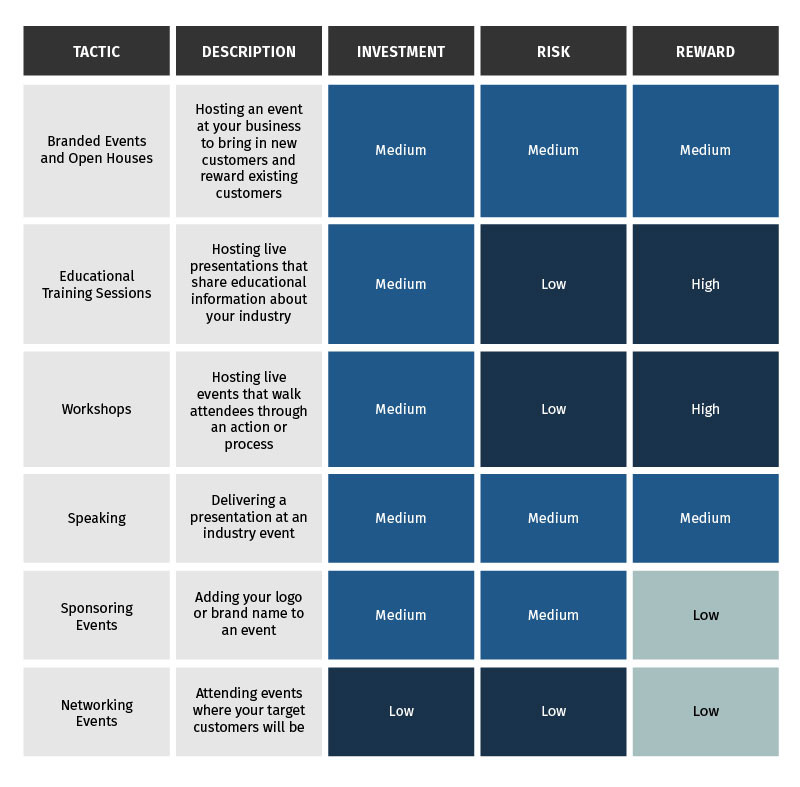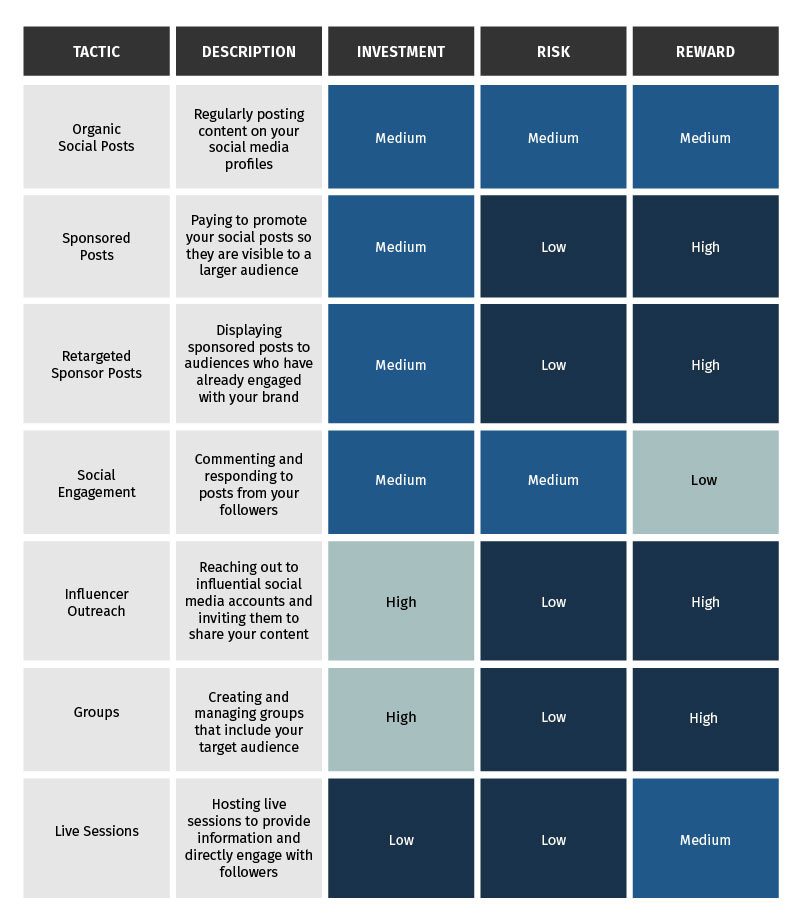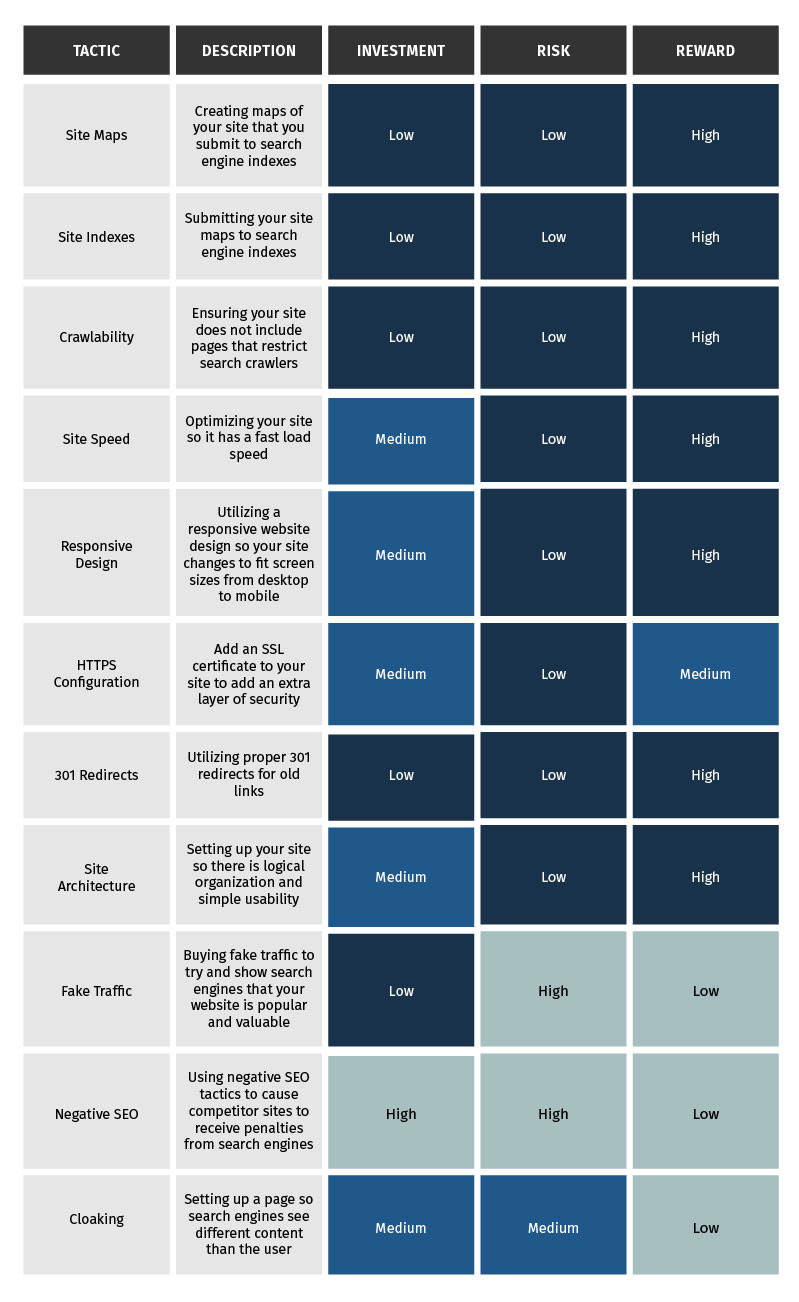When you sit down to create a marketing plan, it can be a little overwhelming. With so many marketing strategies to choose from, it can be difficult to pick the tactics that are right for your business.
On top of that, not all marketing tactics are created equal.
Some strategies require more investment, meaning you must put in extra time, resources, or effort to support them.
Some strategies offer a greater reward and produce more valuable, long-term results than other efforts.
And some marketing strategies even come with a risk. For example, if you engage in black hat or negative SEO marketing strategies, a search engine may catch you, penalize your site, and decrease your search engine rankings. While some black hat strategies may seem like quick wins, they won’t help you grow your business. In fact, you’ll probably lower your search performance, lose quality traffic, and reduce your brand visibility.
So when you consider which types of marketing strategy to use, you should always consider if the risk and reward are worth the investment.
Risky vs. Rewarding Types of Marketing Strategies
To help you decide where to put your energy and how to measure risks, rewards, and investments, we’ve put together this guide to show you how to pick the best marketing tactics for your business.
Strategy Examples
- Traditional marketing: Direct mail, billboards, promotional products
- Event marketing: Workshops, event sponsorships, training sessions
- Content marketing: Blogging, white papers, podcasts
- Social media marketing: Organic social posts, influencer marketing, live sessions
- Paid digital ads: Display ads, video ads, remarketing ads
- SEO: Link building, on-page SEO, technical SEO
Traditional Marketing
Let’s start by looking at traditional marketing tactics. These are basic marketing strategies that have been around for decades. While many modern marketers choose to focus solely on digital strategies, they should still consider a few of these valuable tactics.
When choosing if these marketing strategies are right for your business, consider your target customers. If your audience isn’t very tech savvy, these approaches may help you connect with them in places where they will be more likely to see your messages.
Some of these marketing strategies do come with risk considerations as they relate to investment. A few of the tactics may not be as effective as other tactics; they may be too expensive for the reward. For traditional marketing tactics that come with risks, you may want to test the strategy before investing a great deal of resources.

Event Marketing
Events are another category of offline marketing strategies you may want to consider if your target audience doesn’t spend a majority of their time online.
If your target customers live in your area, hosting local events could offer high rewards. If your target audience often attends national industry events, you may want to participate in those conferences to get exposure as well.
The only real risk in this category also relates to investment versus reward. Event marketing often requires a medium to large investment. You risk losing your investment if you attend or sponsor an event that does not produce results. So do plenty of research before getting involved with an event to ensure your target audience will be there and ready to connect with you.

Content Marketing
Content marketing is a big part of a digital marketing strategy plan. Creating and distributing content is an effective way to both generate and nurture leads.
If your target audience uses search and social media to find answers to their questions and research products and services, you must use content as a part of your marketing strategy.
The risk in this category is relatively low. The riskiest element of content marketing is spending a large amount of resources producing content that audiences don’t respond to. You don’t want to put a lot of time and money into creating content that sounds like a great idea but then doesn’t resonate with your audience. So as you choose these marketing strategies, always keep your target audience in mind. Create content that fills a need and satisfies search intent for each stage of the purchase funnel.

Social Media Marketing
A social media marketing strategy is an effective way to distribute your content and build authentic connections with your target audience.
If your ideal customers regularly use social media platforms, target those sites and build a presence there. You don’t need to be everywhere when it comes to social media. You just need to be where your target audience is.
The risk in using social media marketing is relatively low. The primary way that brands experience social media problems is by posting insensitive or offensive messages. Social media blunders can trigger negativity for your brand. But as long as you have a thoughtful quality assurance process for your posts and comments, you should be able to mitigate these risks.

Paid Digital Ads
So far, we’ve looked at online marketing strategy examples that are organic; most don’t require you to pay for placement. But you can’t rule out paid digital ads as a part of your complete marketing strategy.
Paid digital ads are a great way to get more exposure for your brand, offerings, and content. There are many different platforms and content mediums to choose from. So as you decide where to spend your ad money on marketing strategies, focus on the platforms where your audience spends the most time.
Digital ads don’t come with a lot of risk for brands. But you do want to make sure you don’t give your audience brand fatigue by placing ads in too many places. You may also want to consider whether the investment is worth the reward. For example, in the case of online coupon sites, you may need to invest a high dollar amount to bring in new customers. Always measure the potential return on investment (ROI) before launching ads and discounts.

SEO: Link Building
Search engine optimization (SEO) is a marketing strategy that includes a large group of tactics, so we’ve separated them into three categories. The first of which is link building.
Building links back to your website is one of the most effective SEO strategies, and there are many tactics for creating a deep link profile.
Some types of link building can be risky, and this is an area where marketers often struggle with choosing between black hat and white hat SEO tactics. While it may be tempting to use black hat tactics to gain links back to a website quickly, it’s better to find backlinks and earn them the right way.

SEO: On-Site SEO
The next category of SEO marketing strategies is on-site SEO. This is the part of your strategy that includes SEO content and on-page optimization.
To ensure your investment offers rewards instead of risks, there is a basic rule to guide your efforts. The rule is: Write for readers, not search engines.
While it may seem like stuffing keywords into your content will get better results, it is risky. It could actually hurt instead of help your efforts. As you approach your on-site SEO, stick with tactics that improve the quality of your content while still giving the appropriate signals to search engines.

SEO: Technical SEO
Technical SEO is one of the more complex SEO topics. Because it’s complicated, many brands may want to avoid or overlook these marketing strategies.
But these tactics can substantially help your website improve its rankings and attract more customers and readers. So technical SEO should be a part of every marketing strategy plan.
If you want to avoid risk in this category, remember if something sounds spammy or sketchy, it usually is. Avoid black hat tactics that try and trick search engines or readers, and stick with the strategies that aim to help organically explain, improve, and optimize your pages and website for the benefit of the reader.

Pick the Best Marketing Strategies
Now that you’re familiar with the many types of marketing strategies and understand the investments, risks, and rewards of using each tactic, it’s time to dig in.
Create a marketing strategy that uses the tactics that have the greatest reward at the lowest investment and the least amount of risk for your particular business and goals. Develop a sustainable plan that will build your brand, grow your website traffic, attract new customers, and provide lasting results for years to come.




